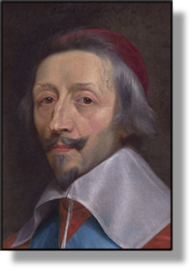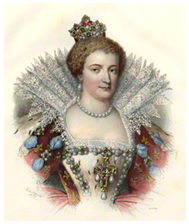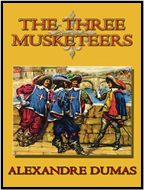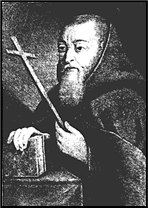


xxxxxThe able Cardinal Richelieu was chief minister to King Louis XIII of France from 1624 until his death. He used his total authority to establish his monarch’s absolute rule, ruthlessly crushing the Huguenots and nobility at home, and reducing the size of Habsburg territory abroad. He rigorously enforced justice and taxation throughout the country, and in 1628 seized the Protestants’ last stronghold at La Rochelle. To reduce the power of the Habsburgs of Spain and Austria, he supported the Protestant Dutch, Danes and Swedes in the Thirty Years’ War, and in 1635 actually went to war with Spain. By the Peace of Westphalia in 1648 France gained much of Alsace, and emerged as the major European power. He encouraged exploration overseas, whilst, at home, as a patron of literature and the theatre, he founded the Académie Française, and did much to ensure the development and purity of the French language.
CARDINAL RICHELIEU
1585 -
Acknowledgements
Richelieu:
detail, triple portrait by he French painter Philippe de
Champaigne (1602-
 xxxxxCardinal Armand Jean du Plessis de Richelieu, to give
him his full title, was chief minister to King Louis XIII of
France from 1624 until his death. As such, he was entrusted with
total authority, and he abused it only in the service of the
Crown. He is remembered above all for his ruthless determination
to establish his monarch's absolute rule, crushing the political
power of the Huguenots and nobility at home, whilst cutting down
the size of the Catholic Habsburgs abroad. Few European monarchs
can boast of a more able, devoted and successful servant to their
cause.
xxxxxCardinal Armand Jean du Plessis de Richelieu, to give
him his full title, was chief minister to King Louis XIII of
France from 1624 until his death. As such, he was entrusted with
total authority, and he abused it only in the service of the
Crown. He is remembered above all for his ruthless determination
to establish his monarch's absolute rule, crushing the political
power of the Huguenots and nobility at home, whilst cutting down
the size of the Catholic Habsburgs abroad. Few European monarchs
can boast of a more able, devoted and successful servant to their
cause.
xxxxxHe was born
in Paris of a noble family and, after entering the church, was
made Bishop of Luçon in 1606. As a member of the States General he
won the favour of Marie de Medici, the regent and queen mother,
but was dismissed when the king dispensed with his mother's rule
in 1617. He regained favour by being a peacemaker between Marie
and her son. He was made a cardinal in 1622 and chief minister to
the king two years later. In this capacity he virtually became
ruler of France. A highly intelligent, hard-
xxxxxIn 1628, determined to put
an end to a spate of rebellions by the Huguenots (Protestants), he
sent government troops to capture their stronghold of La Rochelle,
the last of the fortified cities granted to them by the Edict of
Nantes -
 xxxxxTo keep a check on such disorder, he employed
"Intendants", specially appointed commissioners whose job it was
to oversee all matters of state in their district and report back
to the central authority. Under them, justice was ruthlessly meted
out, and the collection of taxes was rigorously enforced.
Meanwhile, the nobility were hemmed in by royal edicts and, with
the aid of the royal army, were deprived of their family
strongholds and fortresses. And he dealt equally as well with
intrigues within the royal family. In 1630 he overthrew the
conspiracy of the queen mother, Maria de Medici (illustrated),
when she attempted to have him expelled from office. Louis
banished her to Compiègne, but she fled the country and ended her
days in Cologne, a poor and lonely figure. And such was
Richelieu's influence, that he even persuaded the king to sanction
the execution of his young favourite, the Marquis de Cinq-
xxxxxTo keep a check on such disorder, he employed
"Intendants", specially appointed commissioners whose job it was
to oversee all matters of state in their district and report back
to the central authority. Under them, justice was ruthlessly meted
out, and the collection of taxes was rigorously enforced.
Meanwhile, the nobility were hemmed in by royal edicts and, with
the aid of the royal army, were deprived of their family
strongholds and fortresses. And he dealt equally as well with
intrigues within the royal family. In 1630 he overthrew the
conspiracy of the queen mother, Maria de Medici (illustrated),
when she attempted to have him expelled from office. Louis
banished her to Compiègne, but she fled the country and ended her
days in Cologne, a poor and lonely figure. And such was
Richelieu's influence, that he even persuaded the king to sanction
the execution of his young favourite, the Marquis de Cinq-
xxxxxIn foreign policy, he ensured good relations with England by arranging a marriage between the king's sister, Henrietta Maria and the Prince of Wales (later Charles I). But his major aim was to reduce the power and extent of his country's main rival, the Habsburg Empire of Spain and Austria. To this end he willingly supported the Protestant Dutch, Danes and Swedes during the Thirty Years War, and backed uprisings against the Spanish in Catalonia and Portugal. After the death of Gustavus Adolphus, killed at the Battle of Lutzen, he took France into the conflict, declaring war on Spain in 1635 and receiving the blessing of the pope, Urban VIII. With the Peace of Westphalia in 1648 France gained much of Alsace, and emerged as the most powerful country in Europe.
xxxxxIn the
academic field as opposed to the battlefield, Richelieu, a patron
of literature and the theatre, is gratefully
remembered for his founding of the Académie Française (French
Academy), the most famous of the five learned societies
that make up the Institute de France.
On being granted its charter by Louis XIII in 1635, Richelieu
specifically asked that the academy concentrate their efforts on
"the development, unification and purification of the French
language", and, by the continual revision of the Dictionnaire,
this remains their major task today. Richelieu also did much to
encourage exploration -
xxxxxUpon his
death in 1642, Richelieu was buried at the Church of the Sorbonne,
Paris, where his baroque-

xxxxxIncidentally, Louis XIII had little time for his wife, Anne, and in 1625 the Englishman George Villiers, the 1st Duke of Buckingham, caused a scandal at the French court by confessing his love for her. It was around this incident that the French novelist Alexandre Dumas wove his historical novel The Three Musketeers, published in 1844. These three swashbuckling soldiers, together with the dashing D'Artagnan, take on the soldiers of Cardinal Richelieu who, for most of the story, is the villain of the piece. ……
 xxxxx…… Richelieu'sxxsecretary and confidant, Father
Pierre Joseph, was the original "Grey
Eminence" (Éminence grise) -
xxxxx…… Richelieu'sxxsecretary and confidant, Father
Pierre Joseph, was the original "Grey
Eminence" (Éminence grise) -
C1-


